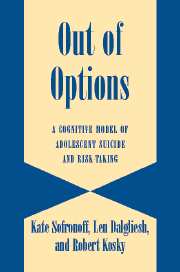Book contents
- Frontmatter
- Contents
- Preface
- Introduction
- 1 Adolescent Suicide: An Overview of the Epidemiology
- 2 Risk and Predisposing Factors in Adolescent Suicide
- 3 Emotional Problems and Adolescent Suicide
- 4 Adolescent Suicide: Cognitive Variables
- ADOLESCENT RISK-TAKING
- A MODEL OF SUICIDE AND RISK-TAKING
- AN EVALUATION OF THE S/RT MODEL
- 9 Depressed and Problem Behavior Adolescents
- 10 Suicide Attempters and Risk Takers
- 11 The Impact of Cognitive Variables as Mediators
- IMPLICATIONS FOR TREATMENT
- References
- Index
9 - Depressed and Problem Behavior Adolescents
from AN EVALUATION OF THE S/RT MODEL
Published online by Cambridge University Press: 03 September 2009
- Frontmatter
- Contents
- Preface
- Introduction
- 1 Adolescent Suicide: An Overview of the Epidemiology
- 2 Risk and Predisposing Factors in Adolescent Suicide
- 3 Emotional Problems and Adolescent Suicide
- 4 Adolescent Suicide: Cognitive Variables
- ADOLESCENT RISK-TAKING
- A MODEL OF SUICIDE AND RISK-TAKING
- AN EVALUATION OF THE S/RT MODEL
- 9 Depressed and Problem Behavior Adolescents
- 10 Suicide Attempters and Risk Takers
- 11 The Impact of Cognitive Variables as Mediators
- IMPLICATIONS FOR TREATMENT
- References
- Index
Summary
So far, the literature reviewed suggests that depressed adolescents and risk-taking adolescents differ from normal adolescents in their problem-solving, risk-assessment, and decision-making capacity. The S/RT model described in Figure 8.2 suggests that early risk factors are precursors to the development of psychopathology such as depression and problem behaviors (conduct disorder and substance abuse problems). Alcohol, stress, and peer pressure may exacerbate these deficits, while protective factors may offer stability to young people in this situation.
This chapter and the next two describe research that shows empirical support for the S/RT model in three distinct ways. This chapter checks that depressive symptomatology and problem behaviors relate to the mediating constructs: problem solving, hopelessness, protective factors, and decision making. Chapter 10 checks that these mediating constructs relate to suicidal behavior and risk-taking behavior. Chapter 11 tests whether these constructs do mediate between depression and problem behaviors on one side and suicidal behavior and risk-taking behavior on the other.
The S/RT model aims to demonstrate links between cognitive constructs and behavioral outcomes. In previous research and in the literature, adolescents are often grouped by terms such as “depressed,” “problem behaviour,” “risk takers,” and “suicidal.” The design used to test the links in the S/RT model uses these groups. Adolescents can also be measured according to their depressive symptoms, problem behaviors, risk-taking behaviors, and suicidal behaviors. Broadly speaking, we note that depressive symptomatology and problem behaviors are like independent variables; suicidal and risk-taking behaviors are like dependent variables.
Information
- Type
- Chapter
- Information
- Out of OptionsA Cognitive Model of Adolescent Suicide and Risk-Taking, pp. 109 - 124Publisher: Cambridge University PressPrint publication year: 2004
